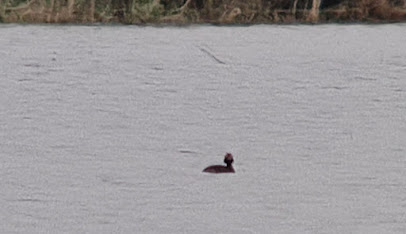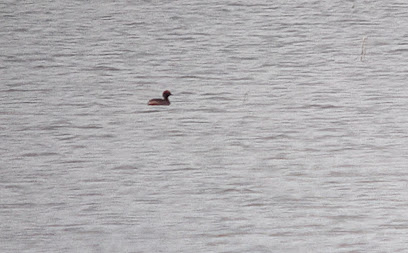Monday dawned drizzly, with low cloud and a light southeasterly wind. It looked like a good day for birding, with this kind of weather conducive for dumping overland-migrating birds at inland locations. I was stuck in the office all day, and when the messages started pinging through of flocks of Arctic Terns dropping in across the York area, I couldn't help but feeling quite gripped! Sandwich Terns, Common Scoters, Grey Plovers and a Little Gull added to my torment, but I enjoyed the collective excitement, albeit vicariously. With a brief break for lunch, I grabbed my bins and cycled down to Dringhouses Pond. This could easily pull in a wayward group of terns; in fact, I saw two storm-blown juveniles here in late October last year, but sadly nothing was doing besides a few bored-looking Tufted Ducks and the resident pair of Great Crested Grebes.
The ace up my sleeve was that I'd arranged to go birding straight from work, so when 5pm came, I cycled furiously home, hoping that the continuing cool, overcast conditions were still favourable for some movement to be happening.
And so it proved. I arrived into an empty hide at North Duffield Carrs and immediately spotted the elegant white forms of Arctic Terns dipping and swerving across the flood water. Excellent! An image I had day-dreamed of for hours was now here to be savoured. Seventeen birds in all, a good count for York, but surpassed by larger counts earlier in the day. Five Common Scoters flew past by field of view, three adult males, a female and a first-summer male, before landing on the flood; a large flock of Black-tailed Godwits wickered as they fed along the bund in front of the hide, together with a black-bellied Dunlin. This was fabulous April birding! The Black-tails constant calling attracted other birds in and the count rose to 130 before many headed north up the valley.
Top: Arctic Terrns, pausing for a rest; bottom: Common Scoters and Arctic TernsThe Arctic Terns were spell-binding, elegant, angular birds, gracefully picking insects from the water surface, using their deeply-forked tails to turn sharply and dip down to the flood. It was hard not to be mesmerised by them and to keep vigilant for another species making an appearance.
The count of Arctic Terns rose to 40 as more birds arrived from the southwest, magically materialising out of the low cloud and joining the feeding throng. Over the next two hours, I counted the birds every ten minutes and I estimated a minimum of 57 birds had passed through, but the maximum could have been three times that. At 8pm, a flock of 14 peeled off from the rest, and I watched as they flocked together and then headed at a sharp angle straight up into the low cloud to the east and out of sight, to embark on the next leg of their epic journey north. The six remaining birds, resting on posts, followed suit a few minutes later, rocketing skywards, calling excitedly. Presumably above the clouds they could navigate to the coast more easily.
Catching a big movement of Arctic Terns inland relies on a number of things lining up, not least the weather and time of year. Also, as far as York is concerned, we need late flooding (as we have this year), to pull birds in for a rest. Usually by now, the floodplain meadows are more meadow and less flood, and with little habitat, terns pass through undetected. On Monday 22nd April, all these things aligned, and I was priveleged to witness the tale-end of this spectacular wildlife phenomenon. In the York area, there were at least 240 birds logged at North Duffield during the day, with a further 70 at Castle Howard, and small numbers at Bank Island and Wheldrake Ings, which may have then passed through NDC later on.



























